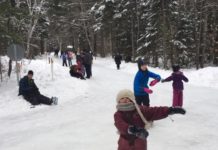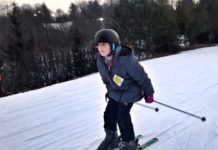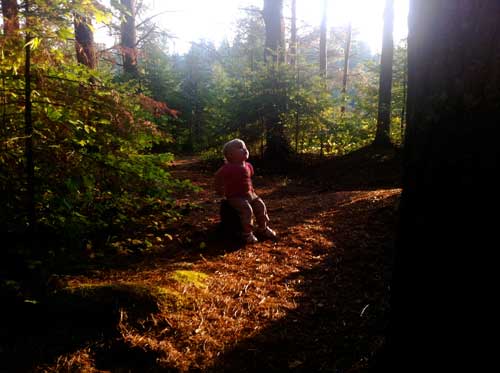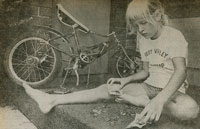“Algonquin, Our home away from home”
By Melodie Percy
It’s safe to say that when it comes to camping in Ontario, I’m completely biased. From the age of two my family, aunts, uncles and grandparents included, loaded up our cars and headed up to Algonquin Park. We did it a few times a year, even winter but my favourite time was always our end of summer trip during the last three weeks of August. The importance of connecting with nature and being in tune with the universal rhythm was instilled at a young age and has become part of who I am. Now as a mom of three myself, I share this with my own children.

Agonquin Park
Algonquin Park is over 7700 square kilometres of breathtaking scenery waiting to be explored. Along the 56 km stretch of highway that runs through the lower portion of the park, you’ll find eight different campgrounds for drive up camping and fourteen different hiking trails of varying lengths. There are plenty of activities in the park to keep you busy. You can go on a guided nature walk with one of the park Naturalists or head to the outdoor Amphitheater to participate in nature talks and learn about the wildlife in Algonquin. My girls love experiencing the natural history of the park at the Logging Museum and the Visitors Centre. When we want to explore the lakes and rivers, renting a canoe is easily done at a few different outfitters. Canoes, paddles and life jackets are delivered directly to your campsite. You can rent them for as long as you desire and they are picked up when you’re finished with them. Also, to make life a little easier, you’ll find three camp stores located in the park for when you run out of something or realize you’re forgotten marshmallows. All of this and more is why we choose Algonquin every year.

Nestled among the pines and surrounded by lakes and rivers is our favourite campground, Poglake. Here the sites are a little more private and every section has a comfort station within walking distance, where you can grab a hot shower.

Car camping in Algonuin Park
Car camping allows us to bring everything we need to be totally comfortable for our stay. This means lists, lists and more lists. I find it helps to imagine a day spent there, and make note of everything that will be used throughout the day. Jotting down ideas while you’re camping helps to make next years trip even better. Most of our camping equipment is packed and stored together. Every year we do a quick run through, wash anything that needs washing and add the items we may have run out of the year before. Keeping a master list with the equipment makes life easier as well.

This is a basic list of what you need when carcamping with the family in Agonquin Park :
Tents and tarps- A good waterproof tent is a must, we use a 10 man for our family of 5 and one rather large dog. I find, it gives us enough room to be comfortable and have a little room for getting dressed. We also use a dining tent but this is definitely not a necessity. We like it because it protects you from bugs and it’s great for playing cards and board games when the weather calls for it. Tarps are also great to set up around your site for extra protection from the elements.
2. Sleeping bags and padding – We all have our own sleeping bag and we use air mattresses to give comfort from tree roots and the cold. As well I always bring extra blankets just in case.
3. Ropes and bungy cords- You need rope for tying down tarps and hanging clothes lines around the site. I like to bring a bag of clothespins as well.
4. An axe or hatchet, a swiss army knife, a shovel and some duck tape- These are a must for campsite maintenance, digging trenches around tents to protect from heavy rain and your nightly campfire.
5. A good first aid kit, with everything you need for mishaps and accidents as well as your favourite natural sun screen and bug spray.
6. Kitchen equipment and Food– The grocery list is up to you, the easier it is to prepare the better has always been our experience, whether you like to cook on the open fire or on a camping stove. We bring lots of fruits, veggies, nuts and seeds because they’re easy to grab on the go for hiking and quick snacks. Eggs, oatmeal and dried cereals are great for quick breakfasts and I like to prepare soups and stews in advance and freeze them in pyrex dishes. They pack well in the cooler, help keep other items cold and they are great to use for an easy dinner or lunch after a day of hiking or canoeing. Make sure you pack all of the utensils and items you will need to prepare the food that you bring; pots, pans, dinnerware, cutlery for eating and preparing meals. Matches or lighters, cutting boards and knives, tinfoil and can openers. We also bring a stainless steel teapot and a bodum for coffee and tea. Anything you will need to eat and clean up including biodegradable soap, bins for washing dishes, tea towels, dish clothes and biodegradable bags for garbage and recycling.

7. Flashlights and lanterns- We bring 2 led rechargeable lanterns and enough flashlights for everyone.
8. Large water jug for gathering water for cooking and doing dishes.
9. Drinking water, the amount you bring totally depends on your family. You will also need some refillable water bottles to use when you’re out hiking for the day.
10. Clothing- It’s best to wear layers and bring items to suit every kind of weather. We pack rain gear, winter vests, polar fleece, touques and mittens. As well as sun hats, bathing suits, shorts and t shirts. In one week you will most likely wear all of it, the days can be warm but the nights can get quite cool. Remember to also pack sensible footwear, hiking boots, running shoes and good sandles. We also bring flip flops for showers at the comfort station.
11. Chairs for sitting around the site and a hammock for relaxing under the trees.
12. A backpack for day trips, canoeing or hiking.
13. We also bring any activities that will keep the kids happy when we’re not hiking or canoeing. Anything from badminton sets and balls, board games, card games and books. It’s been my experience that exploring nature takes up most of their time, but it’s always good to be prepared.
14. Road Trip activities- A few years ago we bought them travel binders that close with a zipper and every year we fill them with fresh paper, stickers, new books and crayons. We give it to them as we are leaving the driveway, this way they can keep journals about their trip and remember long after they’re home. When all else fails, and they are getting restless, we do have DVD players in the car.
The time we spend together camping is invaluable, no electronics and no distractions, just full on family connection in our summer home away from home. Nature becomes our living room and it’s truly amazing to just Be…

Melodie Percy- My journey with natural medicine started over a decade ago, when the quote ‘Let food be thy medicine and thy medicine be thy food’ changed my world. Experiences in my own life have led me to a more natural and proactive approach to health and well being. Now my medicine cabinet consists of herbs, roots, tinctures and other home remedies. This year I’ve decided to start my own herb and vegetable garden and chronicle the adventures of a first time gardener as well as some of my favourite home remedies. As a mom of three, I understand that being my families health advocate is my most important role. I can’t wait to get down in the dirt and share this experience with them.
10 tips to planning a camping trip








